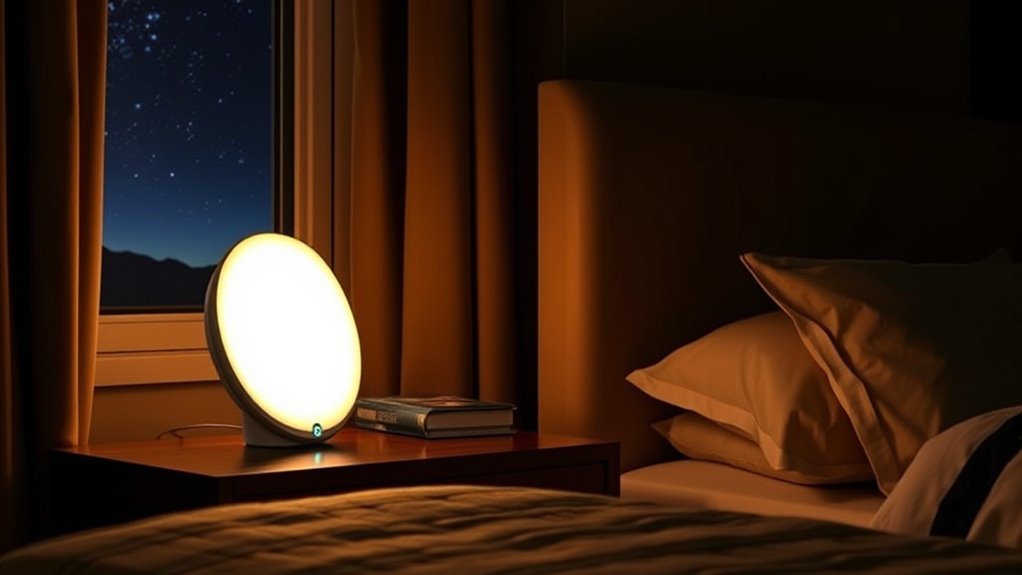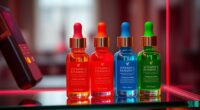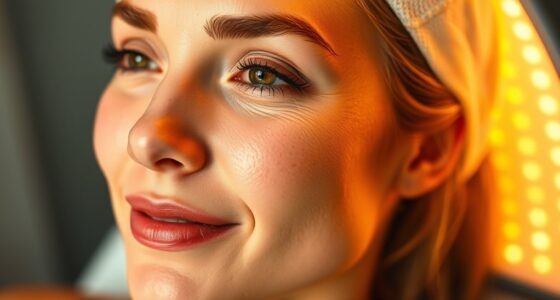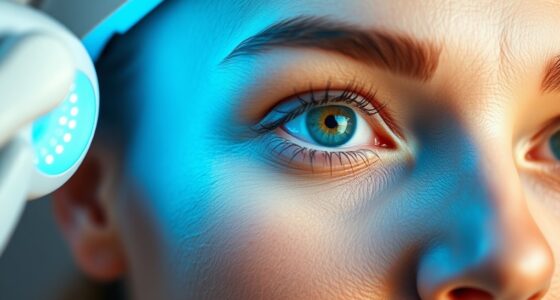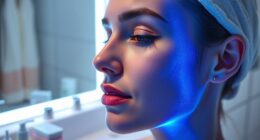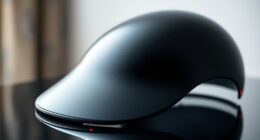To ease jet lag during flights and when you arrive at your hotel, use portable light therapy devices or glasses to help reset your internal clock. Bright light exposure in flight can boost alertness, especially when traveling east, while morning light after landing helps adjust your body to the new time zone. Timing is key—using light therapy correctly can speed up your adjustment. Keep exploring to discover more tips on optimizing your travel experience.
Key Takeaways
- Use portable light therapy devices during flights to stay alert and help reset your internal clock.
- Apply light therapy in hotel rooms, especially in the mornings, to reinforce adaptation to the new time zone.
- Wear light therapy glasses or use portable light boxes to mimic natural sunlight and aid circadian adjustment.
- Schedule light exposure strategically: bright light in the morning to advance your clock or in the evening to delay it.
- Leverage hotel features like large windows or built-in lamps, and supplement with portable devices when natural light is limited.

If you frequently travel across time zones, you know how challenging jet lag can be. The fatigue, disorientation, and sleep disturbances can throw off your entire trip. That’s where light therapy comes in as a promising solution. It’s a simple yet effective way to reset your internal clock by mimicking natural sunlight, helping you adjust more quickly to new time zones. When you’re on a plane or staying in a hotel, using light therapy devices can make a noticeable difference. Portable light boxes or wearable light therapy glasses are designed to deliver the right intensity and spectrum of light, targeting your circadian rhythm and promoting alertness or sleepiness as needed.
During flights, especially long-haul journeys, you can use a portable light device by your seat to stimulate your body’s wakefulness when you need to stay alert. For instance, if you’re traveling eastward and need to wake up earlier, exposure to bright light during your flight can help shift your internal clock forward. Conversely, if you’re heading west and want to extend your evening, avoiding bright light or using a light therapy device in the morning can help delay your body’s rhythm. Once you arrive at your hotel, you can continue using light therapy to solidify your adjustment. Spend time near windows with natural sunlight or use a portable light box in the morning to reinforce your new schedule. This consistency helps your body adapt faster, reducing the fatigue and sleep disruptions that often come with crossing multiple time zones.
Many hotels now offer rooms with large windows or even built-in light therapy lamps, making it easier to get the right exposure without extra equipment. If natural light isn’t available, portable devices become essential. They are especially useful in the mornings, when exposure to bright light signals your body that it’s time to wake up and be alert. If you’re trying to sleep earlier or later than your usual schedule, using a light therapy device in the evening can help shift your circadian rhythm in the desired direction. The key is timing your exposure correctly to maximize benefits and avoid disrupting your sleep.
Frequently Asked Questions
Can Light Therapy Replace Jet Lag Medication?
Light therapy can help reduce jet lag symptoms, but it usually can’t fully replace medication. It works by resetting your internal clock and boosting alertness, especially when timed correctly. However, some people may still need medication for severe symptoms or when light therapy isn’t enough. You should consider combining both options or consulting a healthcare professional to find the best strategy for your travel needs.
Is Light Therapy Safe for Children During Travel?
You can feel confident using light therapy for children during travel, as it’s generally safe when properly supervised. Think of it as a gentle lighthouse guiding their internal clock safely through turbulent seas. Always consult a healthcare professional beforehand, especially for young children. Keep sessions short and monitor their response. With care, light therapy becomes a trusted compass, helping your little one navigate jet lag smoothly and safely.
How Long Should Each Light Therapy Session Last?
You should aim for light therapy sessions lasting about 20 to 30 minutes each. This duration effectively helps reset your internal clock without causing side effects. If you’re new to light therapy, start with shorter sessions and gradually increase as your body adjusts. Be consistent, using the light at the same time daily, especially in the mornings, to maximize benefits and reduce jet lag during travel.
Are There Any Side Effects From Frequent Use?
Yes, there can be side effects from frequent light therapy use. You might experience eye strain, headaches, or skin irritation if the light is too intense or used improperly. Some people also report feeling anxious or restless. To minimize risks, follow the recommended duration and distance from the light source. If you notice any adverse effects, it’s best to stop use and consult a healthcare professional.
Can Light Therapy Improve Sleep Quality on the Plane?
Imagine guiding your mind to a peaceful harbor amid a busy voyage; light therapy can help. Yes, it can improve your sleep quality on the plane by regulating your internal clock. As you sit in your seat, using a portable light device signals your body it’s time to rest, making it easier to drift into restful sleep despite the constant hum of the aircraft. This gentle nudge can truly enhance your in-flight experience.
Conclusion
Just like Odysseus relied on his cunning to navigate treacherous waters, you can harness light therapy to conquer jet lag and restore your energy. By integrating in-flight and hotel light strategies, you regain control over your circadian rhythm and reclaim your vitality. Remember, as the sun rises anew each day, so too can your body reset with the right light. Embrace these tools, and let your travels be marked by resilience and renewal.
